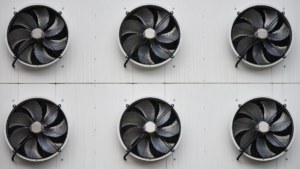 A whole-house fan is an alternative to central air conditioning. Normally installed in the ceiling that separates your home from the attic, they draw warm air in from the top floor of your house and force it out through the eaves in the roof. This creates negative pressure that pulls in fresh air through your home’s doors and windows.
A whole-house fan is an alternative to central air conditioning. Normally installed in the ceiling that separates your home from the attic, they draw warm air in from the top floor of your house and force it out through the eaves in the roof. This creates negative pressure that pulls in fresh air through your home’s doors and windows.
Even though they don’t chill the air in your home, whole-house fans create a natural cooling effect, making it feel up to thirty degrees colder. And, unlike air conditioners, their effect is noticeable right away. As soon as you turn them on, hot, stale air is whisked away and replaced by a refreshing breeze.
Advantages of a Whole-House Fan
Whole-house fans are extremely efficient. They can cool your entire house for a fraction of the cost of an air conditioner. Even at full power, they consume only 10-15 percent as much energy and the price to purchase and install them is significantly lower as well. Their simple construction also reduces maintenance costs. Most fans can run for years without any issues.
Even though whole-house fans are normally used in place of air conditioners, they can also be used to supplement them. House fans are most effective during mornings and evenings when the air outside is cool. When temperatures climb too high, you can switch over to your air conditioner, then back to your house fan as the day cools off. This not only allows you to maintain a comfortable environment at minimal cost but also prolongs the life of your air conditioner at the same time.
Best Climate for a Whole-House Fan
Because they work on the principle of evaporation, whole-house fans are most effective in dry climates. When moisture evaporates off your skin, it carries away body heat, lowering your core temperature. Wind accelerates this process, which is why whole-house fans are so refreshing.
However, in humid environments, the air is already saturated with moisture and evaporation can’t occur. Homes in areas where humidity regularly climbs above fifty percent, such as the Gulf Coast, won’t benefit from a whole-house fan, while coastal regions with four seasons and mild summers, where temperatures rarely reach above 90°F, will benefit most.
Effect on Air Quality
Besides helping you cool off, installing a whole-house fan improves air quality as well. Circulating air through your home eliminates dust, pollen, pet dander, smoke, and dangerous fumes. Fewer pollutants helps keep your allergies under control and promote overall health.
Cover Your Cooling System
Agway doesn’t just power your home. We protect it through our EnergyGuardTM program. When your air conditioning or electrical lines malfunction, we step in and cover the cost of repairs. There are no deductibles or service fees. Just a low monthly rate. Every customer is enrolled as soon as they join, so sign up today and make sure your cooling systems have the support they need to function reliably.